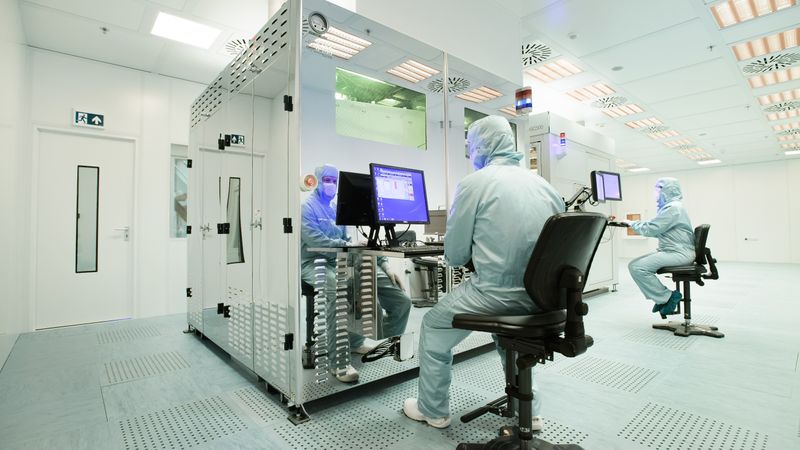Benefits of Electroforming: 9 reasons to manufacture precision metal parts with Electroforming
Electroforming is an additive manufacturing process specialized for the production of high precision metal parts. Its uniqueness is that you can grow metal parts atom by atom, providing extreme accuracy and high aspect ratios. Typical precision of a electroformed part goes down to 1 to 2 μm, which is beyond what most other manufacturing technologies can reach.

Electroforming Veco
So what makes Electroforming the choice of leading companies across industries for manufacturing high precision metal components? See below 9 reasons why you should consider Electroforming as an engineer for your next innovation.
1) Cost reduction
With Electroforming, there isn’t substantial investment on equipment to start a production. This makes Electroforming cost effective from prototyping to mass production. With many manufacturing techniques, you’ll need additional tooling or machinery before you can start the process. Take die-cutting for example a punch will be required to invest before production can be arranged.
With many other metal fabrication methods such las laser cutting or milling, every piece is handled one by one, resulting in longer lead time especially with larger volumes. Electroforming on the other hand allows you to simultaneously grow a large number of high-tolerance parts in one go, which makes it very suitable and efficient for large volume production. Production cost can therefore be reduced from volume production and efficiency improvement with Electroforming.
-> Learn more in details about how Electroforming can help reduce costs.
2) Perfect replicability from prototypes to mass production
The electroforming technology is known for perfect replicability and reproducibility, due to the fact that the process allows for extremely precise duplication of the mandrel. The high resolution of the conductive patterned substrate enables finer geometries, tighter tolerances, and superior edge definition. This results in perfect process control, high-quality production, and very high repeatability.
With metal fabrication methods like Milling (-> read more in deatils about comparison if Electroforming and Milling here), the machine needs to mill every piece one by one, which directly affects the time that is required to produce larger volumes. This is also the case with many other processes like laser procedures: every metal part needs to be individually cut out. Electroforming on the other hand allows you to simultaneously grow a large number of high-tolerance parts in one go. The more metal pieces that are needed, the more interesting electroforming becomes.
Electroforming is therefore perfectly suitable for high precision surface replication at low cost and in high volumes.
3) High-precision metal parts
With the trend of miniaturization, manufacturing industries see an increasing demand for metal parts of very high precision. In the new generation of production development and design, components at micron or even submicron level are in the demand— demand that conventional techniques such as laser cutting (-> read more in details about comparison of Electroforming and Laser Cutting here) or stamping can’t meet.
Electroforming in combination with advanced lithography process can be the technique to meet the demands of miniaturization by providing the next level high-precision sheet metal parts. With Electroforming, high precision sheet metal components can be made with extreme accuracy. The standard deviation of most critical feature can be only ~0.1 µm on one single part.
4) Freedom of design
The process of manufacturing high precision components straight from CAD design files is an obvious indicator of freedom of design. Without large investment to start production, Electroforming can be used for fast prototyping or mass production, or more ideally both.
Electroforming is thus very suitable for the future-proof experimental approach for next generation of product design and development: a design method where various versions of component designs are made to see which one works best. Instead of using different manufacturing method and handling with multiple suppliers for different components, Electroforming can be the one stop solution for different designs from prototyping to industrial production.
5) Short lead and delivery times
With Electroforming, short lead time and delivery time can be realized. Compared with other manufacturing technologies which requires more time consuming processes, Electroforming process is much more time efficient. In stamping, for example, a die may take up to months to build. In CNC Punching, a die is available within days to weeks. After that the realization of the die, the creation process is yet to be initiated. A mold that is used for Electroforming, on the contrary, can be produced within hours with the Laser Direct Imager.
Electroformed components can therefore be created and delivered within 3 weeks — and usually even sooner, depending on the complexity of the project and co-development procedures.
6) Multi-layer structures
Electroforming is not limited to producing 2D structures because additional layers can be grown by repeating the deposition process. These additional layers can reinforce thinner electroformed parts, making them easier to handle and less fragile. Moreover, these additional layers can be grown in different directions, which can provide more delicate structures to meet complex design and functional demand. The multiple layer capability brings new possibilities for many industries that demand complex precision metal solutions.
7) Straight side walls, free from burr or stress
With Electroforming perfectly straight side walls can be achieved with no burr or stress, which is important for many components. This demand is hard to be met with other techniques. With traditional laser processing methods, for example, you will often end up with side walls that are relatively rough on the edges due to heat influence.
8) Special conical hole shape with non-clogging benefits
Electroforming allows you to manufacture components with very unique conical hole shape. This enables us to provide high performance filtration sieves with self-releasing advantage, the filter won’t easily clog and stays clean for a longer use.
Besides filtration the unique conical hole shape sees applications in various industries including medical. Our Electroformed nebulizer nozzle plate plays an essential role in the state of art nebulizer, releasing millions of micron-sized droplets per second through its unique geometry, forming a perfect fine mist for targeted delivery to the lung.
9) Alteration of material properties
Electroforming allows for alteration of material properties, so different material properties can be achieved with the same material. When altering material properties doesn’t suffice, for example if high corrosive resistance is demanded for special application, or a particular material is necessary to be in contact of human skin, that’s when coatings comes in. A layer of material such as palladium or gold can be coated followed by Electroforming process.
Interested to learn more about our Electroforming technology? Download our Whitepaper of Electroforming here
